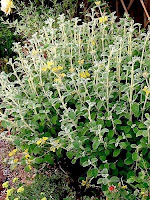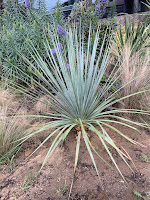Latin name: Nolina nelsonii ("no-LEE-nah nell-SOWN-ee-eye")
Common name: Blue Nolina, Nelson's Bear Grass
Originally from: Northern Mexico
Blooms: Tiny white flowers on a giant spike in spring.
Light: Full sun.
Water: Winter rain is enough.
Height x width: 6-10' x 3-4'
Zones: 8a to 10b
Where to find in P. Garden: We have three nice big ones down at the North end of PRG
At some point in your plant growing life you think "Yeah - I've really got this down: I can tell the difference between an Agave, an Aloe and a Yucca at 20 paces. Send me my Girl Scout Plant ID badge please!" Shortly thereafter you stumble across a Nolina and there's a lot of humming and hawing while you try to figure it out.
In this case, I decided to get some
Nolinas so I could get to know the genus. We have three
Nolina nelsonii down at PRG and they have grown into nice big plants with lovely blue leaves. So far, they're very tough - no water, full sun, and nobody has killed one by stomping on it or letting their dog pee or poop on it yet.
Commonly called bear grass, perhaps because members of the Lewis and Clark
expedition, 19th century explorers of western America thought they were big, tough, bear-like grasses, even though they're not a grass. And since they couldn't tell the difference between several genera of plants they called them all bear grass (Yuccas, Xerophyllum and various Nolinas) so that only adds to the confusion.
According to San Marcos Growers:
The genus was named by Andre Michaux
(1746-1802), a French botanist sent to North America by King Louis XVI.
His name honors Abbé Pierre Charles (P.C.) Nolin, a French agriculturist
and horticultural author. This species was first collected in 1898 by
the naturalist Edward W. Nelson (1855-1934) at an elevation in the
mountains near Miquihuana between 7,000-9,000 feet in the state of
Tamaulipas, Mexico. It was described in 1906 and named to honor Nelson
by famed American botanist Joseph Nelson Rose (1862-1928), who with
Nathaniel Lord Britton published the four volume tome "The Cactaceae".
There
are 28 species in the genus, all native to Mexico and the Southern US.
They're dioecious plants, meaning they have males and females.
Nolina nelsonii comes from the desert and mountain regions of Northern Mexico. It's easy to grow, grows slowly with (eventually) one or more trunks to create
outstanding 3-4’ across heads of slightly serrated (but not sharp) bluish 1” wide leaves. One mature, a thick bloom stalk 4’ tall pops up, holding thousands of creamy yellow, scented flowers - after flowering, that head dies but the plant will produce more. It likes ordinary soil, hates wet feet, is very deer resistant, and needs nothing but rain to water it in the Bay Area.

























